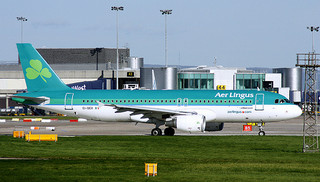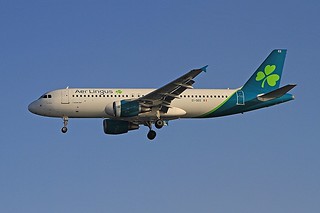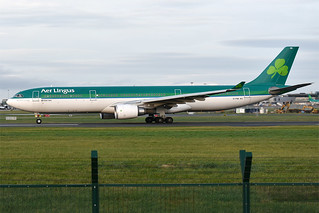Lingus A20N enroute on Sep 20th 2024, loss of radio and radar contact
Last Update: July 24, 2025 / 18:40:11 GMT/Zulu time
Incident Facts
Date of incident
Sep 20, 2024
Classification
Incident
Airline
Aer Lingus
Flight number
EI-506
Departure
Dublin, Ireland
Destination
Bordeaux, France
Aircraft Registration
EI-NSF
Aircraft Type
Airbus A320-200N
ICAO Type Designator
A20N
The aircraft was able to depart for the return flight with a delay of about 90 minutes.
The French BEA reported: "Air traffic control lost radio and radar contact while the aircraft was cruising at FL330. The crew continued and descended to their destination. Contact was reestablished at FL100." and rated the occurrence an incident. The occurrence, classified as "Failure or malfunction of a circuit or component (not part of the powertrain)", is being investigated.
On Jul 23rd 2025 the BEA added, that two similiar occurrences were identified over a period of 7 months, all three occurrences are handled by one investigation. A preliminary report in French and preliminary report in English has been released on Jul 23rd 2025. The two other occurrences are: Incident: Transavia A21N over France on Apr 29th 2025, loss of radar contact, loss of separation and Incident: Transavia A21N near Bordeaux on Jan 13th 2025, radar and radio contact lost, alert and distress phases triggered.
The BEA summarized the sequence of events on this flight (translated from the French report):
The crew of the Airbus A320neo registered EI-NSF took off from Dublin Airport (Ireland) at 6:24 a.m. bound for Bordeaux-Mérignac Airport (33), with the call sign EIN50V. The captain was PM and the co-pilot was PF on this flight.
Approximately 15 minutes before beginning descent, while cruising at FL330, the crew is in contact with an air traffic controller from CRNA-Ouest (Brest Control) and receives instructions to fly directly to the Cognac VOR-DME (CNA). The captain begins to hear crackling in his headset. The crew noticed that the display alternated between normal and an amber message VHF PAGE NOT AVAIL on RMP 1 (Radio Management Panel), and between normal and a blank screen on RMP 2. The crew also reported repeated triggering of the following ECAM alerts and memos, associated with the illumination of the Master Caution button and the emission of a Single Chime type audible signal: NAV ATC/XPDR STBY, TCAS STBY, COM RMP 2 OFF, COM RMP 1 FAULT.
At 7:22 a.m., the aircraft disappeared from the controller's radar screen. The controller called the crew to perform a radio test. The crew replied that they were having a problem with the communications system and their transponder. The controller asked them to maintain FL 330. The messages sent by the crew were received with poor sound quality and audible alarms could be heard in the background.
Radio contact was then lost. The aircraft reappears temporarily twice on the controller's screen before disappearing at 7:27 a.m. until the end of the flight. The CRNA-Ouest controller notifies the CRNA-Sud-Ouest (Bordeaux Control) controller of the arrival in his sector of an aircraft without radar contact.
The crew reported that they had attempted several resets of each RMP and to select transponder code 7600, without success. The crew stated that the cockpit had become completely silent and that they could not hear each other in their headsets. The crew then believed that they would be intercepted by military aircraft. The captain consulted the “Air-Ground Communication Failure” procedure in the operations manual. He indicated that, being in VMC, he was following the corresponding part of the procedure, which requires landing at the nearest suitable aerodrome.
He considers this aerodrome to be the destination aerodrome, Bordeaux-Mérignac. He chooses to descend according to his flight plan, as programmed in the FMS, in order to comply with the altitude constraints of the arrival and approach procedures. This strategy also allows him to
minimize flight time.
Coordination between the various civil control centers and military agencies begins. The CRNA-Southwest notifies the CMCC of the loss of transponder on this aircraft and informs them that the aircraft appears to be visible on Flightradar24.
The CRNA-Ouest triggers the alert phase (ALERFA) with the ARCC8 at 7:31 a.m.
The CRNA-Ouest calls the 709 Cognac-Châteaubernard Air Base (16) to inform them of a loss of radio and radar contact with the EI-NSF, which could potentially interfere with their zones. The military controller indicates that he can see the aircraft on Flightradar24 and on primary radar. CRNA-Ouest reports the loss of radio and radar contact to CAPCODA-TN. No in-flight assistance is mentioned in this exchange.
CRNA-West transfers responsibility for the aircraft to CRNA-Southwest and transmits the frequency of CRNA-Southwest by radio. This transmission is not received by the crew and remains unanswered.
At 7:33 a.m., the crew begins descent.
At 7:34 a.m., CRNA-Southwest calls Cognac-Châteaubernard Air Base 709, which informs it that the aircraft is 30 NM in the 350° direction from the air base, and mentions possible assistance from fighter jets via the activation of the operational standby service. The crew stated in their testimony that RMP 2 became active again and that it could only transmit on the 121.800 MHz frequency.
In this region, this frequency corresponds to the ground frequency of Tarbes-Lourdes-Pyrénées Airport (65). Radio contact was established at 7:34 a.m. between the Tarbes-Lourdes-Pyrénées controller and the crew. The crew asked the controller to relay its position and intentions to the Bordeaux-Mérignac approach control center.
The crew regained the ability to change radio frequencies and transmitted a message on the distress frequency 121.5 MHz, then on the Mérignac Approach frequency (121.200 MHz) 11, without receiving a response. Radio contact was finally reestablished at 7:39 a.m. on 121.5 MHz with the CDC12 in Montde-Marsan. The crew reported descending to FL 80 on the STAR CNA 2K. They confirmed to the military controller that they did not need assistance and requested a radio frequency.
At 7:41 a.m., CRNA-Sud-Ouest, which was also monitoring the 121.5 MHz frequency, asked it to contact “Bordeaux” on the 132.990 MHz frequency.
At the same time, the minimum separation between flights EFW59L and EIN50V is 3.2 NM laterally and approximately 175 ft vertically.
At 7:42 a.m., the crew contacts CRNA-Southwest on 132.990 MHz. They report descending to FL 80 on the CNA 2K arrival procedure and, at the controller's request, indicate that they are passing FL 125. After being transferred to the approach controller, the crew reported at FL 100 descending to FL 80. The controller asked the crew to confirm their flight level and then asked flight EFW59L to turn left to heading 090°. The two crews of flights EFW59L and EIN50V collated this message at the same time and both turned to heading 090°. Flight EFW59L was then 500 ft above flight EIN50V. This double collation was not noted by the controller.
The crew of EIN50V declared a “PAN PAN.” The crew stated in their testimony that the ILS 23 frequency was not automatically selected by the FMS and that they could not do so manually on their MCDU. The crew considered making an RNP approach. They finally used the STBY NAV function on the RMP and managed to select the ILS 23 frequency. After two holding patterns over the IAF VAGNA, the crew was cleared for the ILS 23 approach, then for landing. The crew landed without further incident.
During the stopover, a maintenance organization tests the transponders and both RMPs. The test results reveal no anomalies. The return flight proceeds without any particular incident.
Aircraft Registration Data
Incident Facts
Date of incident
Sep 20, 2024
Classification
Incident
Airline
Aer Lingus
Flight number
EI-506
Departure
Dublin, Ireland
Destination
Bordeaux, France
Aircraft Registration
EI-NSF
Aircraft Type
Airbus A320-200N
ICAO Type Designator
A20N
This article is published under license from Avherald.com. © of text by Avherald.com.
Article source
You can read 2 more free articles without a subscription.
Subscribe now and continue reading without any limits!
Read unlimited articles and receive our daily update briefing. Gain better insights into what is happening in commercial aviation safety.
Send tip
Support AeroInside by sending a small tip amount.
Related articles
Lingus A320 at Madrid and Dublin on Apr 24th 2024, chemical odour on board
An Aer Lingus Airbus A320-200, registration EI-DEJ performing positioning flight EI-593 from Madrid,SP (Spain) to Dublin (Ireland) with 2 crew on…
Lingus A21N at Washington on Aug 30th 2023, false landing and tail strike
An Aer Lingus Airbus A321-200N, registration EI-LRD performing flight EI-117 from Dublin (Ireland) to Washington Dulles,DC (USA), was landing on…
Lingus A320 at Frankfurt on May 30th 2025, smell in cabin
An Aer Lingus Airbus A320-200, registration EI-DER performing flight EI-657 from Frankfurt/Main (Germany) to Dublin (Ireland), was climbing through…
Lingus A320 at Dublin on Jan 14th 2025, unusual attitude and upset on approach
An Aer Lingus Airbus A320-200, registration EI-DEE performing flight EI-493 from Faro (Portugal) to Dublin (Ireland), was descending towards Dublin…
Lingus A333 at Dublin on Feb 11th 2025, engine stall on departure
An Aer Lingus Airbus A330-300, registration EI-FNH performing flight EI-121 from Dublin (Ireland) to Orlando,FL (USA), was climbing out of Dublin's…
Newest articles
UPS MD11 at Louisville on Nov 4th 2025, burst into flames on takeoff
A UPS United Parcel Service McDonnell Douglas MD-11, registration N259UP performing flight 5X-2976 from Louisville,KY to Honolulu,HI (USA) with 3…
India A20N near Bhopal on Nov 3rd 2025, cargo smoke indication
An Air India Airbus A320-200N, registration VT-EXO performing flight AI-2487 from Delhi to Bangalore (India) with 172 people on board, was enroute at…
Subscribe today
Are you researching aviation incidents? Get access to AeroInside Insights, unlimited read access and receive the daily newsletter.
Pick your plan and subscribePartner

ELITE Simulation Solutions is a leading global provider of Flight Simulation Training Devices, IFR training software as well as flight controls and related services. Find out more.
SafetyScan Pro provides streamlined access to thousands of aviation accident reports. Tailored for your safety management efforts. Book your demo today
AeroInside Blog
Popular aircraft
Airbus A320Boeing 737-800
Boeing 737-800 MAX
Popular airlines
American AirlinesUnited
Delta
Air Canada
Lufthansa
British Airways







